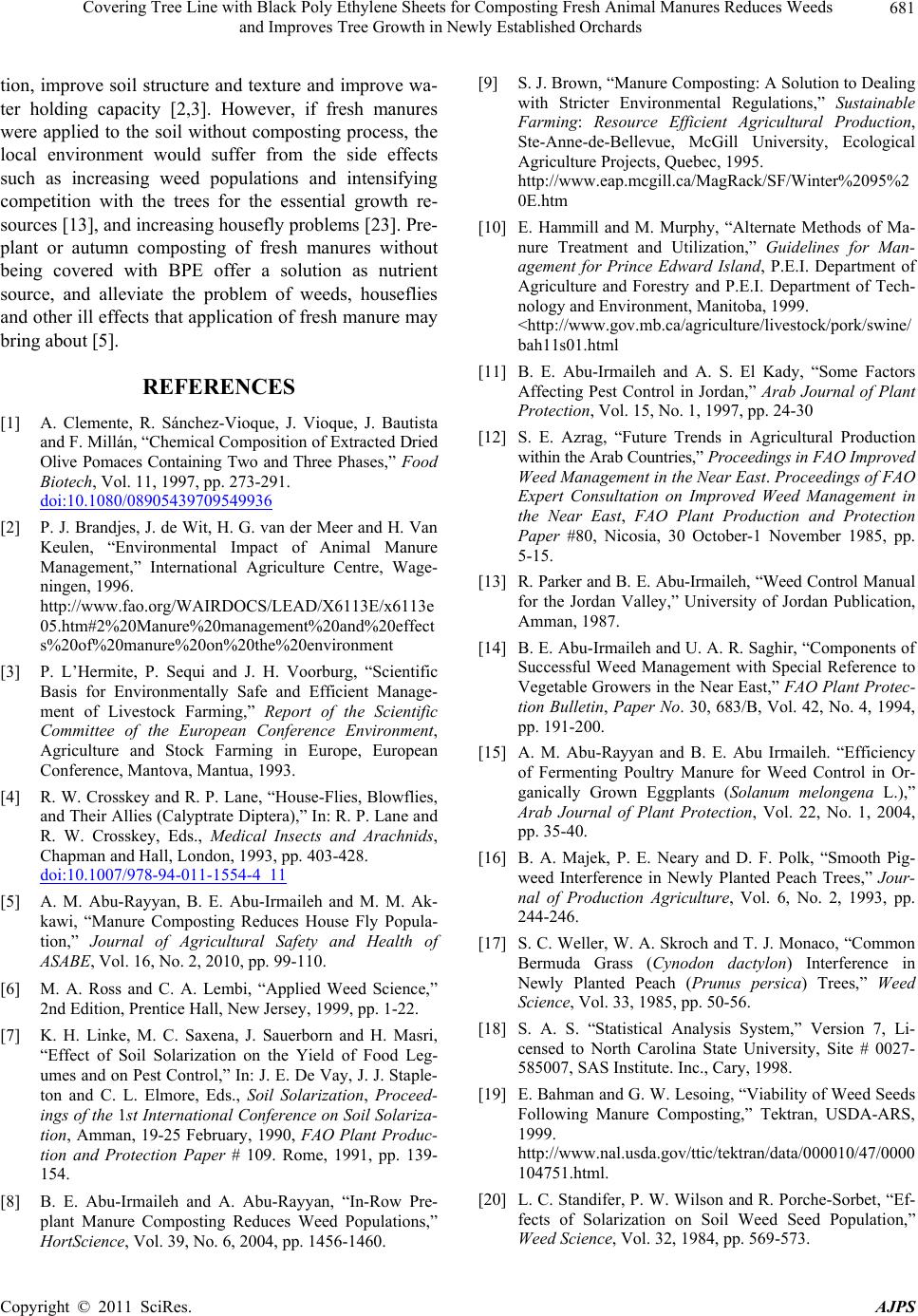
Covering Tree Line with Black Poly Ethylene Sheets for Composting Fresh Animal Manures Reduces Weeds 681
and Improves Tree Growth in Newly Established Orchards
tion, improve soil structure and texture and improve wa-
ter holding capacity [2,3]. However, if fresh manures
were applied to the soil without composting process, the
local environment would suffer from the side effects
such as increasing weed populations and intensifying
competition with the trees for the essential growth re-
sources [13], and incr easing housefly problems [2 3]. Pre-
plant or autumn composting of fresh manures without
being covered with BPE offer a solution as nutrient
source, and alleviate the problem of weeds, houseflies
and other ill effects that application of fresh man ure may
bring about [5].
REFERENCES
[1] A. Clemente, R. Sánchez-Vioque, J. Vioque, J. Bautista
and F. Millán, “Chemical Composition of Extracted Dried
Olive Pomaces Containing Two and Three Phases,” Food
Biotech, Vol. 11, 1997, pp. 273-291.
doi:10.1080/08905439709549936
[2] P. J. Bran djes, J. de Wit, H. G. van der Me er and H. Van
Keulen, “Environmental Impact of Animal Manure
Management,” International Agriculture Centre, Wage-
ningen, 1996.
http://www.fao.org/WAIRDOCS/LEAD/X6113E/x6113e
05.htm#2%20Manure%20management%20and%20effect
s%20of%20manure%20on%20the%20environment
[3] P. L’Hermite, P. Sequi and J. H. Voorburg, “Scientific
Basis for Environmentally Safe and Efficient Manage-
ment of Livestock Farming,” Report of the Scientific
Committee of the European Conference Environment,
Agriculture and Stock Farming in Europe, European
Conference, Mantova, Mantua, 1993.
[4] R. W. Crosskey and R. P. Lane, “House-Flies, Blowflies,
and Their Allies (Calyptrate Diptera),” In: R. P. Lane and
R. W. Crosskey, Eds., Medical Insects and Arachnids,
Chapman and Hall, London, 1993, pp. 403-428.
doi:10.1007/978-94-011-1554-4_11
[5] A. M. Abu-Rayyan, B. E. Abu-Irmaileh and M. M. Ak-
kawi, “Manure Composting Reduces House Fly Popula-
tion,” Journal of Agricultural Safety and Health of
ASABE, Vol. 16, No. 2, 2010, pp. 99-110.
[6] M. A. Ross and C. A. Lembi, “Applied Weed Science,”
2nd Edition, Prentice Hall, New Jersey, 1999, pp. 1-22.
[7] K. H. Linke, M. C. Saxena, J. Sauerborn and H. Masri,
“Effect of Soil Solarization on the Yield of Food Leg-
umes and on Pest Control,” In: J. E. De Vay, J. J. Staple-
ton and C. L. Elmore, Eds., Soil Solarization, Proceed-
ings of the 1st International Conference on Soil Solariza-
tion, Amman, 19-25 February, 1990, FAO Plant Produc-
tion and Protection Paper # 109. Rome, 1991, pp. 139-
154.
[8] B. E. Abu-Irmaileh and A. Abu-Rayyan, “In-Row Pre-
plant Manure Composting Reduces Weed Populations,”
HortScience, Vol. 39, No. 6, 2004, pp. 1456-1460.
[9] S. J. Brown, “Manure Composting: A Solution to Dealing
with Stricter Environmental Regulations,” Sustainable
Farming: Resource Efficient Agricultural Production,
Ste-Anne-de-Bellevue, McGill University, Ecological
Agriculture Projects, Quebec, 1995.
http://www.eap.mcgill.ca/MagRack/SF/Winter%2095%2
0E.htm
[10] E. Hammill and M. Murphy, “Alternate Methods of Ma-
nure Treatment and Utilization,” Guidelines for Man-
agement for Prince Edward Island, P.E.I. Department of
Agriculture and Forestry and P.E.I. Department of Tech-
nology and Environment, Manitoba, 1999.
<http://www.gov.mb.ca/agriculture/livestock/pork/swine/
bah11s01.html
[11] B. E. Abu-Irmaileh and A. S. El Kady, “Some Factors
Affecting Pest Control in Jordan,” Arab Journal of Plant
Protection, Vol. 15, No. 1, 1997, pp. 24-30
[12] S. E. Azrag, “Future Trends in Agricultural Production
within the Arab Countries,” Proceedings in FAO I m p r ove d
Weed Management in the Near East. Proceedings of FAO
Expert Consultation on Improved Weed Management in
the Near East, FAO Plant Production and Protection
Paper #80, Nicosia, 30 October-1 November 1985, pp.
5-15.
[13] R. Parker and B. E. Abu-Irmaileh, “Weed Co ntrol Man ual
for the Jordan Valley,” University of Jordan Publication,
Amman, 1987.
[14] B. E. Abu-Irmaileh and U. A. R. Saghir, “Components of
Successful Weed Management with Special Reference to
Vegetable Growers in the Near East,” FAO Plant Protec-
tion Bulletin, Paper No. 30, 683/B, Vol. 42, No. 4, 1994,
pp. 191-200.
[15] A. M. Abu-Rayyan and B. E. Abu Irmaileh. “Efficiency
of Fermenting Poultry Manure for Weed Control in Or-
ganically Grown Eggplants (Solanum melongena L.),”
Arab Journal of Plant Protection, Vol. 22, No. 1, 2004,
pp. 35-40.
[16] B. A. Majek, P. E. Neary and D. F. Polk, “Smooth Pig-
weed Interference in Newly Planted Peach Trees,” Jour-
nal of Production Agriculture, Vol. 6, No. 2, 1993, pp.
244-246.
[17] S. C. Weller, W. A. Skroch and T. J. Monaco, “Common
Bermuda Grass (Cynodon dactylon) Interference in
Newly Planted Peach (Prunus persica) Trees,” Weed
Science, Vol. 33, 1985, pp. 50-56.
[18] S. A. S. “Statistical Analysis System,” Version 7, Li-
censed to North Carolina State University, Site # 0027-
585007, SAS Institute. Inc., Cary, 1998.
[19] E. Bahman and G. W. Lesoing, “Viability of Weed Seeds
Following Manure Composting,” Tektran, USDA-ARS,
1999.
http://www.nal.usda.gov/ttic/tektran/data/000010/47/0000
104751.html.
[20] L. C. Standifer, P. W. Wils on and R. Porche-Sorbet, “Ef-
fects of Solarization on Soil Weed Seed Population,”
Weed Science, Vol. 32, 1984, pp. 569-573.
Copyright © 2011 SciRes. AJPS